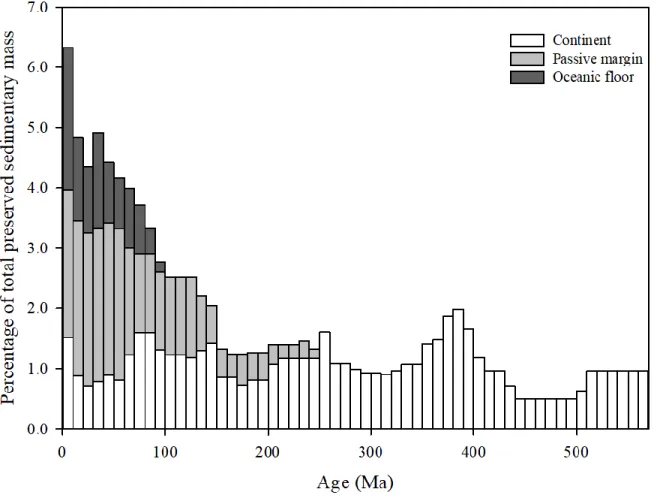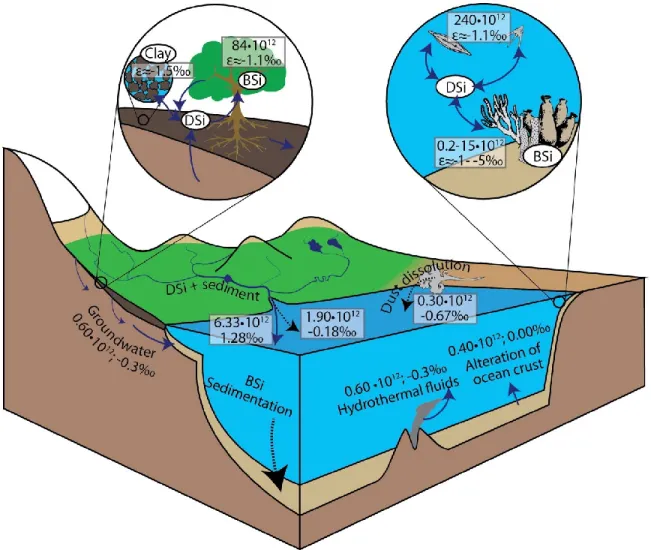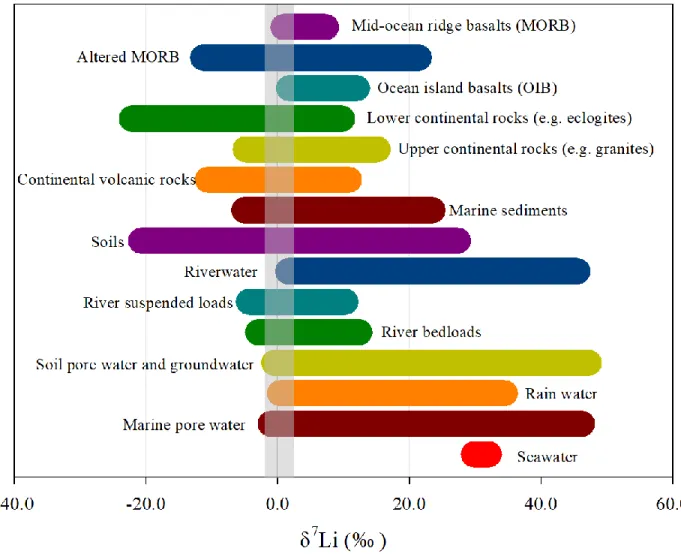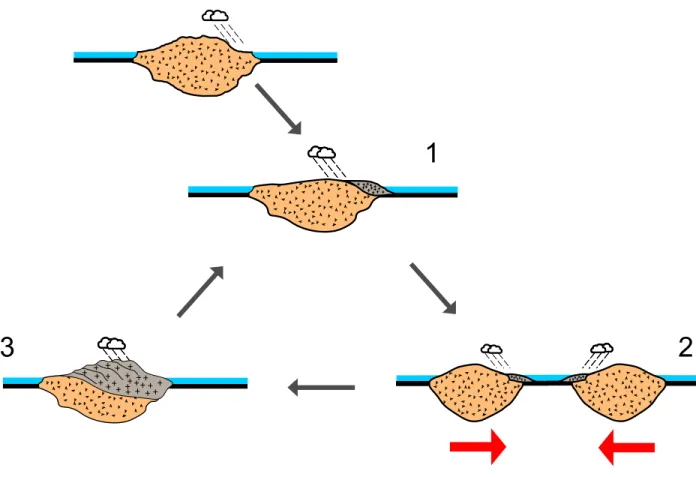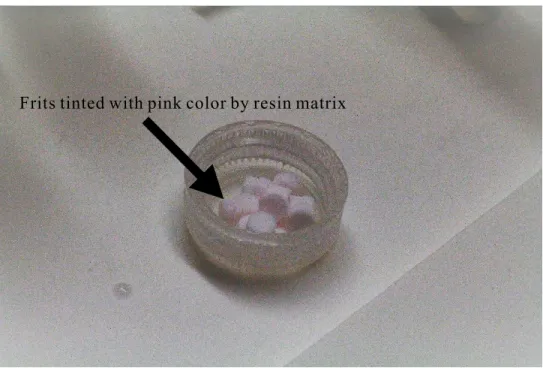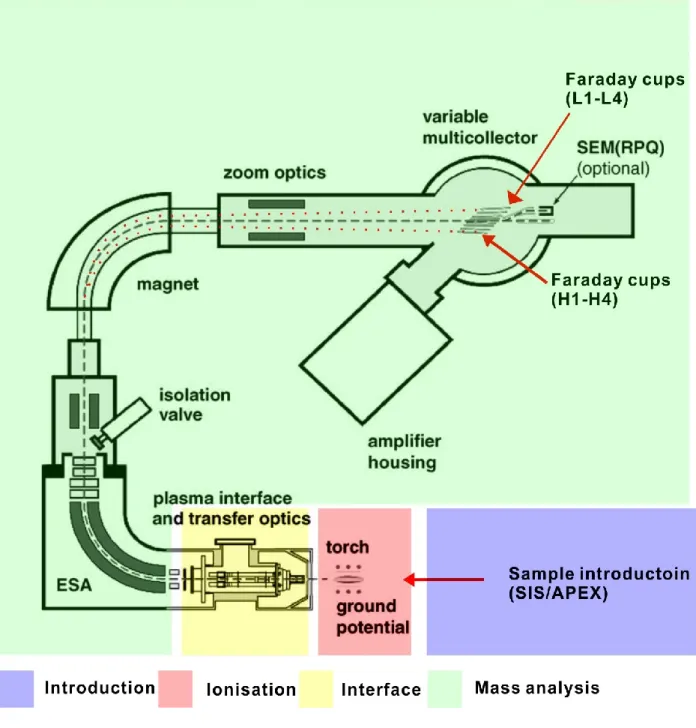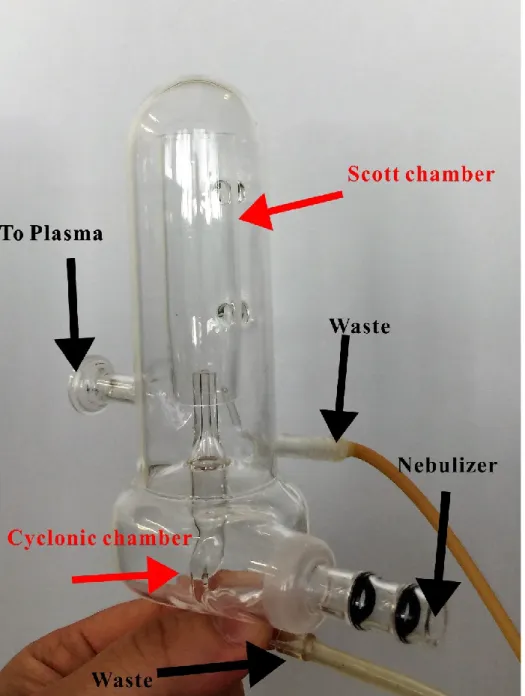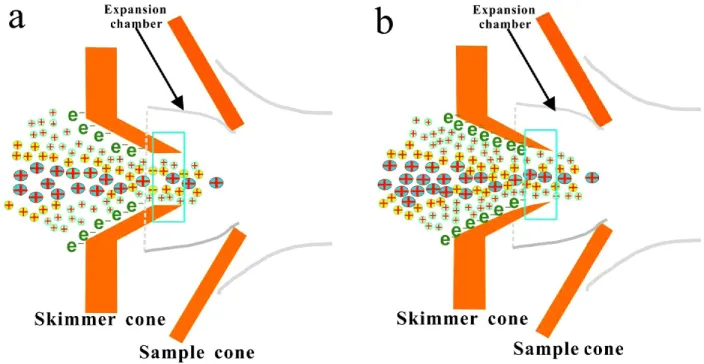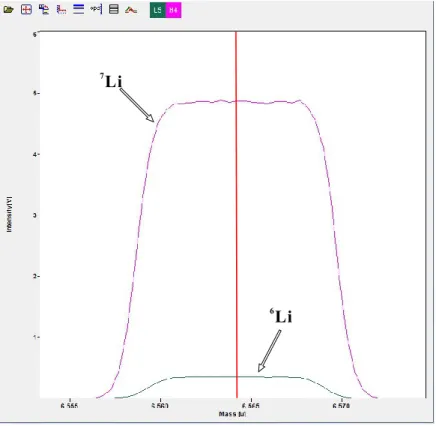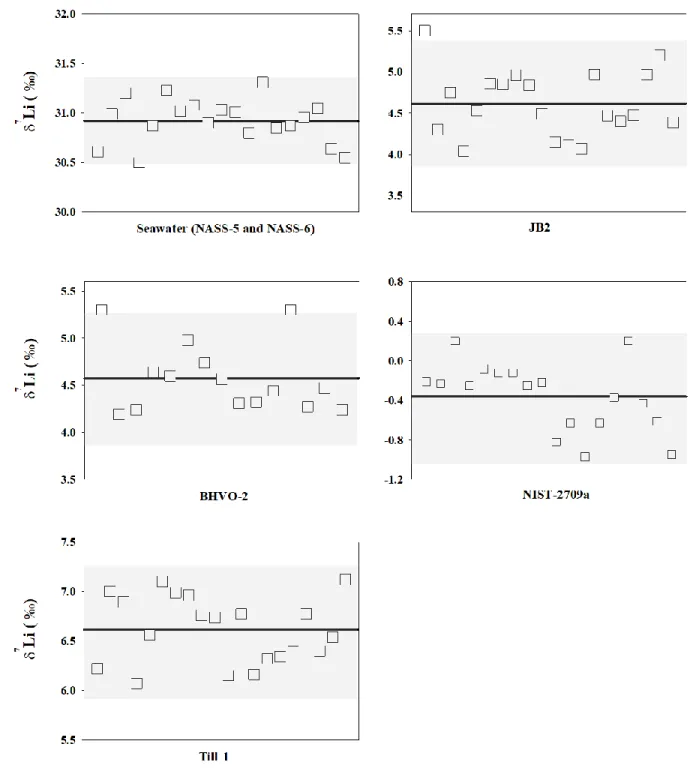HAL Id: tel-03070776
https://hal-insu.archives-ouvertes.fr/tel-03070776
Submitted on 12 Apr 2021
HAL is a multi-disciplinary open access
archive for the deposit and dissemination of sci-entific research documents, whether they are pub-lished or not. The documents may come from teaching and research institutions in France or abroad, or from public or private research centers.
L’archive ouverte pluridisciplinaire HAL, est destinée au dépôt et à la diffusion de documents scientifiques de niveau recherche, publiés ou non, émanant des établissements d’enseignement et de recherche français ou étrangers, des laboratoires publics ou privés.
Xu (yvon) Zhang
To cite this version:
Xu (yvon) Zhang. Sedimentary recycling and chemical weathering: a silicon and lithium isotopes perspective. Geochemistry. Institut de Physique du Globe de Paris, 2018. English. �tel-03070776�
Thèse préparée
à l’INSTITUT DU PHYSIQUE DU GLOBE DE PARIS
École doctorale STEP’UP-ED N°560
IPGP - Équipe Géochimie des enveloppes externes
Sedimentary recycling and chemical
weathering: a silicon and lithium isotopes
perspective
Par
Xu Zhang
Présentée et soutenue publiquement le
28 Septembre 2018
Thèse de doctorat de Sciences de la Terre et de l'environnement
Dirigée par Jérôme Gaillardet
Devant un jury composé de :
Rachael James Rapportrice Professeure (Université de Southampton, UK)
Sophie Opfergelt Rapportrice Professeure (Université catholique de Louvain, Belgique)
Christian France-Lanord Membre Directeur de recherche (CRPG, Nancy)
Jiubin Chen Membre Professeur (Université de Tianjin, Chine)
Marc Benedetti Membre Professeur (Université Paris Diderot, IPGP)
Julien Bouchez Co-encadrant Chargé de recherches (IPGP)
Jérôme Gaillardet Directeur de thèse Professeur (Université Paris Diderot, IPGP)
i
Résumé
Les actions combinées du cycle de l'eau et le cycle des roches résultent en un transport de sédiments des continents aux océans. Il a été proposé que dans l'océan, les sédiments détritiques réagissent avec l'eau de mer lors de processus encore mal compris, connus sous le terme d'« altération inverse », consommant des cations, formant des minéraux authigènes et libérant du CO2.
Sur de longues échelles de temps, les sédiments détritiques sont convertis en roches sédimentaire et « recyclées », sous l'effet de la surrection tectonique, c'est-à-dire ramenées à la surface de la Terre.
Cette thèse étudie ces processus au travers (1) d'expériences en laboratoire (2) d'une étude de terrain sur des sédiments d’un delta d'âge Éocène, déposés dans des conditions continentale et marine, et (3) sur la base d'analyses des sédiments de 42 fleuves mondiaux. Notre approche est en particulier basée sur des systèmes isotopiques "non traditionnels" : Si et Li. Les résultats expérimentaux montrent que les argiles adsorbent le Li marin en occasionnant un important fractionnement isotopique (∆7Li
min/solution ~ 20‰). L'étude terrain indique que le δ7Li enregistre
l’interaction entre l’eau de mer et les sédiments détritiques et de ce fait signe l'« altération inverse » se produisant dans les environnements deltaïques et y couplant les cycles du Li, du Si, et du Fe. Enfin, les isotopes du Si suggèrent que les roches sédimentaires exercent une influence majeure sur la composition des particules actuellement transportées à la mer, et que ceci pourrait sur le long terme affaiblir la capacité d'absorption du CO2 atmosphérique par l'altération des silicates sur les
continents.
ii
Abstract
At the Earth surface, the interplay between the water cycle and the rock cycle leads to transport of materials from the continents to the sea. In the ocean, detrital sediments are thought to react with seawater through a set of hypothesized, but yet-under constrained, processes called “reverse weathering” which consume cations, form authigenic clays, and liberate CO2. Over
long-time scales, sediments are transformed into sedimentary rocks. Under the action of tectonic uplift these sedimentary rocks are "recycled" back to the Earth surface.
This thesis investigates these processes through (1) a set of laboratory experiments; (2) the close examination of detrital sediments deposited in environments varying from alluvial to marine at an Eocene delta; and (3) the role of sedimentary rocks in erosion and weathering, using the geochemistry of river sediments from 42 world rivers. These objectives have been achieved using "non-traditional" isotope systems: Si and Li. First, our experiments show that detrital clays exhibit a strong capacity to adsorb Li and fractionate seawater Li isotopes (∆7Li
min/fluid ~ 20‰). Second,
the field data show that seawater composition (especially δ7Li) can be modified by interacting with
detrital sediments over geological time scales, and that deltaic “reverse weathering"-type processes result in a coupling between the Li, Si, and Fe cycles. Third, Si isotopes suggest that the recycling of sedimentary rocks has a major influence on the composition of sediments currently transported to the ocean, and that this possibly results in a long-term weakening of the capacity of continental silicate weathering to consume atmospheric CO2.
Key words: Silicon, Lithium, Isotopes, Chemical weathering, Reverse weathering, Sedimentary cycle
iii
Acknowledgements
As you may know, authors who often write acknowledgements at the end of their masterpieces, although it appears at the beginning. This is the same case here, I start writing this part after realizing that I have finished ~300 pages for this thesis and knowing that there are so many people involved in this thesis. To begin with, I sincerely appreciate the equal opportunity offered by the Initial Training Networks, project ISONOSE, under Marie Skłodowska-Curie Actions from European commission, which was granted to me, a non-European citizen, and made this thesis possible. Among me and my European colleagues and supervisors, our cultural backgrounds and histories separate us; however, our pursuit of truth, our insistence on ethics, our values on equality, and our passion in science unite us.
Next, I would like to thank my supervisors, Jérôme Gaillardet and Julien Bouchez, because they chose me in the first place and babysat me for almost four years. I still remember the Skype interview I had with these two gentlemen, during which I was so pretentious that I did not even smile. I am truly grateful that they had faith in me even after have met me in person after my arrival at IPGP. Jérôme has always been supporting my free thinking, either in daily work or on Twitter, and casually sharing his expertise and thoughts based on decades of experience with me, a junior who is standing at the entrance level of his career. I am also equivalently thankful to Julien, who has spent a lot of time, energies, and tolerance on me at IPGP rather than with his new born children. He is always accessible and insightful, for example, during my writing Julien has offered me massive corrections and criticisms like a true hater or an intelligent senior who is trying his best to guide me in my academic journey.
iv
Also, I want to thank Rachel James, Marc Benedetti, Sophie Opfergelt, Jiubin Chen, Christian France-Lanord, Jerome Gaillardet, Julien Bouchez, and Laure Barrier for being members of my jury.
Next, I would share my gratitude to my colleagues. Pascale Louvat, Julien Moureau, Jessica Dallas, thank you for your help and instruction on measurements on Neptune, the core analysis of this thesis. Laurie Barrier and Amandine Laborde, thank you for the wonderful field trip in Spain and thoughtful guidance in sedimentology. Frédéric Monier, Emily Pringle, Alkis Gourgiotis, Emile Bolou, Soufian Henchiri, Jean-louis Birck, Laëticia Faure, Pierre Burckel, Samia Hidalgo, Laure Cordier, Agnès Michel, Hassiba Lazar, Delphine Limmois, and Caroline Gorge thank you for helping me to accomplish my analysis, without you this project won’t be accomplished. Also Wafa Abouchami, Catherine Chauvel, Louis Derry, and Vincent Busigny, thank you for sharing your time and wonderful discussions with me. Moreover, Inma Lopez, Irina Shilobreeva, Martine Rodier, and Lydie Guillerot, thank you for helping me sort out my issues with finance, visa, and health care in France, the champion of the World Cup of Paperwork. Also, I want to thank my group members at GEE, Matthieu Buisson, Claire Rollion-Bard, Laure Meynadier, Fatim Hankard, Eric Gayer, Antoine Cogez, Damien Guinoiseau, Hongming Cai, Johanna Noireaux, Mathieu Dellinger, Nicole Fernandez, and Damien Calmels, thank you for sharing your great time with me, it was four solid wonderful years.
I would also thank for my colleagues in Toulouse, in particular, for the experiment study of this thesis. Giuseppe Saldi, you deserve a huge credit for all the help, work, and intelligence you have devoted into this project. Jacques Schott, thank you for your confidence on this project and your wise direction of me to finish our experiments. Although I have invited you two to restaurants twice, I still believe that you deserve more acknowledgements. Also, I thank Franziska Stamm and
v
Maria Cristina Castillo Alvarez for your help when I was in Toulouse, and all those researchers who have helped this project.
Now I would share my thanks for the isonosers. Maja Tesmer, thank you for all your organization and all your efforts, I understand it was challenging to deal with all the professors, students, and EU office at the same time, and you have done your best to keep the success of the project. All the PIs, Friedhelm von Blanckenburg, Balz Kamber, Seán McClenaghan, Emma Tomlinson, Rachael James, Anna Gorbushina, Eric Oelkers, Jacques Schott, Claudia Bouman, and Joachim Albrecht, thank you for sharing your ideas, your experience, and your suggestions. My Isonose-mates, Rasesh Pokharel, Daniel Frick, Marie Küßner, Ann-Kristin Kalveram, Nils Suhr, Carolina Rosca, David Fries, Jens Krüger, Cristina Castillo, Franziska Stamm, Grant Craig, Danijela Mavrić and Ruben Gerrits, all those meetings at Prague, Potsdam, Dublin, Zandvoort, and Sorèze have became memorable experiences and there will always a connection among us in the future.
I thank for all my friends for have supported me in various forms during my time in Paris. The little group among Paul Floury, Sara Milner Garcia, Marie Kuessner, Quentin Charbonnier (occasional group member 1), Rene Kapannusch (occasional group member 2), thank you for all those great memories of my PhD. My friends who traveled all the way to Paris just to hang out with me: 钱霓,江瑜,陈立果,曾向南,李皑,Will Matthews, Catherine You, Michael Henry, Ansis Rosmanis, Lauren Kotecki, Liam Buller, Serge Bidon, and Charles Paillet, thank you, it was cool.
At the end, I thank for my family back in China, especially 张弢 and 曾庆碧, who happened to be my parents.
vi
vii
Table of contents
Résumé ... i
Abstract ... ii
Acknowledgements ... iii
Table of contents ... vii
Figure List ... xi
Table list... xiv
Chapter 1: Introduction ... 1
1.1 Weathering: a pivotal process for the evolution of the Earth surface compartments ... 3
1.1.1 Weathering and the hydrosphere ... 4
1.1.2 Weathering and lithosphere ... 9
1.1.3 Weathering, the atmosphere, and the biosphere ... 14
1.2 Reverse weathering: the missing link between river sediments and sedimentary rocks 17 1.3 The Si and Li isotope systems ... 19
1.3.1 Si isotope system... 21
1.3.2 Li isotope system ... 24
1.3.3 A Si-Li paradox in sedimentary cannibalistic recycling ... 27
1.4 Objectives of this dissertation ... 29
Bibliography ... 35
Chapter 2: Methods and techniques ... 43
2.1 Samples and reagents ... 44
2.1.1 Depth-profile sampling ... 44
2.1.2 Laboratory protocols ... 44
2.2 Major and trace elements ... 46
2.3 Purification of Si and Li ... 47
2.3.1 Alkaline fusion ... 47
2.3.2 Si separation ... 48
2.3.3 Li separation... 50
2.4 Isotope measurements by MC-ICP-MS (Neptune/Neptune Plus) ... 63
viii
2.4.2 Ionisation system ... 68
2.4.3 Interface ... 69
2.4.4 Mass analysis ... 70
2.4.5 Analytical sessions on a MC-ICP-MS ... 72
2.4.6 δ30Si measurements ... 73
2.4.7 δ7Li measurements ... 77
Bibliography ... 82
Chapter 3: Experimental investigation of the possible impact of reverse weathering on Lithium isotope composition in seawater ... 87
3.1 Introduction ... 88
3.2 Materials and experimental methods... 91
3.3 Analytical protocol ... 95
3.4 Thermodynamic calculations ... 99
3.5 Results ... 99
3.6 Discussion ... 112
3.6.1 Kaolinite dissolution in acidic seawater (experiment (1)) ... 112
3.6.2 Interaction between basaltic glass and seawater (experiment (2)) ... 116
3.6.3 Interaction between kaolinite and seawater (experiment (3)) ... 120
3.7 Conclusion ... 130
Bibliography ... 132
Chapter 4. “Reverse weathering” reactions: insights from Si and Li isotopes at a paleo-detaic environment ... 136
4.1 Introduction ... 137
4.2 Sample material ... 142
4.2.1 The Ainsa Basin and its mid-Eocene deltaic system ... 142
4.2.2 Sample description ... 143
4.3 Analytical methods ... 147
4.3.1 Sample preparation and major and trace element concentrations ... 147
4.3.2 Selective extraction of Li pools ... 147
4.3.3 Lithium isotope measurements ... 148
4.3.4 Silicon isotope measurement ... 149
4.3.5 Neodymium isotope measurement ... 150
ix
4.4.1 Thin section ... 151
4.4.2 Major and trace elements ... 154
4.4.3 Li isotope system ... 164
4.4.4 Silicon isotope system... 164
4.4.5 Neodymium isotopes system ... 166
4.4.6 Water rinsing and HCl leaching experiments ... 167
4.5 Discussion ... 168
4.5.1 Impact of reverse weathering on the chemical and isotope composition of sediments ... 169
4.5.2 Coupling between Si, Li, and Fe cycles in deltas ... 176
4.5.3 Contribution of deltaic processes to the oceanic cycles of Si and Li ... 183
4.6 Conclusion ... 185
Bibliography ... 188
Appendix i: ... 195
1. Water rinsing experiments ... 195
2. Leaching experiments ... 197
Chapter 5: “Source-to-sink-to-source” effects on the Si isotope composition of detrital sediments ... 205
5.1 Introduction ... 206
5.2 Sample material ... 211
5.2.1 River depth profiles: Amazon and Mackenzie rivers ... 214
5.2.2 Sediments from other large rivers ... 222
5.3 Analytical methods ... 225
5.4 Results ... 226
5.5 Discussion ... 231
5.5.1 Negligible biological effects on the δ30Si of river sediments ... 231
5.5.2 δ30Si and δ7Li variations in large river bed sands ... 232
5.5.3 Mineralogical controls on the δ30Si of large river sediments ... 233
5.5.4 Interpretation of large river sediment δ30Si in terms of the geological context .... 243
5.5.5 Contribution of bedload transport to total sedimentary fluxes of large rivers from Si isotopes 244 5.5.6 The evolution of the river sediment Si isotope composition through continental recycling ... 247
x
5.5.7 Can we still use the δ30Si composition of detrital sediments to trace weathering
regimes? ... 260
5.6 Conclusion and implications ... 262
Bibliography ... 264
Appendix ii ... 275
xi
Figure List
Figure 1.1 Ocean residence time against seawater ̶ UCC partition coefficient _____________ 6 Figure 1.2 Secular variation of seawater Li isotope ___________________________________ 8 Figure 1.3 REE diagram (normalized to chondrites) ________________________________ 10 Figure 1.4 Nd model age vs. depositional age of sedimentary rocks _____________________ 13 Figure 1.5 The global mass-age distribution of the sedimentary mass at the Earth surface ___ 14 Figure 1.6 Simplified schematic of the silicate-carbonate feedback _____________________ 16 Figure 1.7 Schematic of the present-day global Si cycle ______________________________ 22 Figure 1.8 Silicon isotopic signature of Earth surface material _________________________ 23 Figure 1.9 Present-day geochemical cycle of Li at Earth surface _______________________ 25 Figure 1.10 Lithium isotopic signature of Earth surface materials ______________________ 26 Figure 1.11 Sedimentary rock δ30Si and δ7Li signatures against their Al/Si ratios __________ 29
Figure 1.12 Schematic of sedimentary cannibalism _________________________________ 30 Figure 2.1 Calibration curve for diluted seawater Li purification ______________________ 56 Figure 2.2 Examples of unsuccessful Li purification of seawater _______________________ 57 Figure 2.3 Separation of Li using column chromatography protocol ____________________ 59 Figure 2.4 Calibration curves of two-step Li separation ______________________________ 59 Figure 2.5 Example of resin matrix tinting eluting out and tinting the frits _______________ 62 Figure 2.6 Schematic of a MC-ICP-MS___________________________________________ 65 Figure 2.7 Photograph of a quartz-made “Stable Introduction System” __________________ 66 Figure 2.8 Schematic of the APEX sample introduction system ________________________ 68 Figure 2.9 Schematic of two types of nickel-made skimmer cones______________________ 70 Figure 2.10 Example of a “mass scan” of Si isotope peaks ____________________________ 75 Figure 2.11 δ29Si vs. δ30Si throughout this study ____________________________________ 76
Figure 2.12 Summary of δ30Si analyses for the basalt reference material BHVO-2 _________ 76
Figure 2.13 Example of a “mass scan” around Li isotope peaks ________________________ 79 Figure 2.14 Summary of δ7Li analyses for the pure Li solutions _______________________ 79
Figure 2.15 Summary of δ7Li analyses for the reference materials ______________________ 81
Figure 3.1 Schematic of the experimental system ___________________________________ 94 Figure 3.2 Protocol of Li separation _____________________________________________ 98 Figure 3.3 SEM images of fresh and reacted kaolinite recovered from experiment (1) _____ 105
xii
Figure 3.4 SEM images of kaolinite for experiment (3) _____________________________ 108 Figure 3.5 7Li NMR spectra of kaolinite in experiments (d) __________________________ 110
Figure 3.6 Thermodynamic calculation (PHREEQC) of saturation index _______________ 111 Figure 3.7 Results of experiment (1) ____________________________________________ 113 Figure 3.8 Preferential release of Li over Si during the dissolution of kaolinite ___________ 114 Figure 3.9 Results of experiment (2) ____________________________________________ 119 Figure 3.10 Results of experiment (3) ___________________________________________ 122 Figure 3.11 Two scenarios explaining the Li isotope fractionation in the system__________ 125 Figure 3.12 Evolution of seawater δ7Li and sea-level from the late-Cretaceous __________ 128
Figure 3.13 Schematic for the impact of the variation of sea-level on the seawater δ7Li ____ 129
Figure 4.1 Schematic of mixing between detrital sediments and authigenic clays _________ 138 Figure 4.2 Maps of the sampling area __________________________________________ 144 Figure 4.3 Optical microscopy images of the thin sections ___________________________ 153 Figure 4.4 Relationship between Li concentration and the sum of Al and Fe concentrations_ 155 Figure 4.5 Frequency distribution of Li/Al and Li/Fe ratios. __________________________ 155 Figure 4.6 Relationship between the Na/(Al+Fe) and Li/(Al+Fe) ratios _________________ 156 Figure 4.7 Relationship between Li isotope composition and grain size_________________ 165 Figure 4.8 Relationship between Si isotope composition and grain size _________________ 166 Figure 4.9 δ7Li composition of the bulk sample, the first step of the HCl leaching, and the third
step of the HCl leaching ______________________________________________________ 168
Figure 4.10 δ7Li vs. Al/Si ratios for alluvial sediments from the Ainsa basin and for sediments
from modern large rivers _____________________________________________________ 175
Figure 4.11 Relationship between δ30Si and the Si/Fe in Ainsa sediments. ______________ 178
Figure 4.12 Relationship between δ7Li and the Li/(Al+Fe), Li/Al, and Li/Fe ratios in Ainsa
sediments. _________________________________________________________________ 180
Figure 4.13 Relationship between δ7Li and Li/Fe __________________________________ 182
Figure 5.1 Map of large rivers studied for Si isotope composition _____________________ 213 Figure 5.2 "Three-isotope plot" (δ29Si against δ30Si) _______________________________ 226
Figure 5.3 Relationship between the δ30Si and δ7Li in river sediments __________________ 230
Figure 5.4 Relationship between feldspar content and grain size ______________________ 235 Figure 5.5 Relationship between δ30Si and grain size _______________________________ 236
xiii
Figure 5.6 Compilation of δ30Si in world’s river waters _____________________________ 250
Figure 5.7 Large river sediment δ30Si as a function of grain size ______________________ 252
Figure 5.8 Schematic evolution of the mineralogical composition of large river sediment __ 258 Figure 5.9 Relationship between weathering intensity (W/D) and difference in silicon isotope
xiv
Table list
Table 2.1 Protocol for Si separation ______________________________________________ 49 Table 2.2 Single-step procedure for Li separation ___________________________________ 54 Table 2.3 Li separation protocol using 1-ml resin columns ____________________________ 60 Table 2.4 Typical performing conditions of Neptune plus for δ30Si measurements _________ 74
Table 2.5 Literature values of δ30Si for BHVO-2 ___________________________________ 77
Table 2.6 Typical analytical conditions of the Neptune Plus for δ7Li measurements ________ 78
Table 2.7 Literature values of δ7Li seawater and basalt reference materials. ______________ 80
Table 1.1 Protocol of making artificial seawater (ASW) solution _______________________ 92 Table 1.2 Li separation protocol using the 1 ml resin method __________________________ 97 Table 1.3 Experiment (1): Dissolution of kaolinite (KGa-2) powder in artificial seawater __ 100 Table 1.4 Experiment (2): Interaction between basaltic glass and Li-doped artificial seawater 101 Table 1.5 Experiment (3): Interaction between kaolinite and Li-doped artificial seawater ___ 102 Table 1.6 Summary of adsorption experiment _____________________________________ 103 Table 1.7 Reported Li isotope fractionation factor (α) from experimental studies _________ 124 Table 4.1 Sample depositional environment, location, δ7Li and δ30Si compositions (in ‰), εNd,
and Al/Si ratios result ________________________________________________________ 145
Table 4.2 Summary of thin section examinations __________________________________ 152 Table 4.3 Summary of major elements expressed as oxides (%) _______________________ 157 Table 4.4 Summary of trace elements concentrations (in ppm) ________________________ 160 Table 5.1 Silicon isotope composition of river sediments from the Amazon Basin ________ 216 Table 5.2 Silicon isotope composition river sediments from the Mackenzie Basin ________ 219 Table 5.3 Silicon isotope composition of river sediments across the world ______________ 223 Table 5.4 Si isotope composition and Al/Si ratio in primary minerals __________________ 240 Table 5.5 Dissolved and particulate Si fluxes to the ocean ___________________________ 245 Table 5.6 Calculation of relative flux of sediments (RBS and SPM) ___________________ 247
1
Chapter 1: Introduction
2 Weathering: Making the earth of the Earth
It is surprising how compatible human beings from different cultures can be when talking about planets. When looking at a flaming planet in the night sky, our ancestors from western cultures named it after the god of war from Roman mythology, Mars, and our ancestors from eastern cultures simply called this planet as “火星”, meaning the planet of fire. When talking about the planet where we live, there is no cultural diversity. In French, a beautiful language which I am still learning, it is called “la Terre”. The French name is not substantially different from how it is called in my scientific working language, English, the Earth. In my mother tongue, Chinese, it is called “地球” which literally means “the sphere of earth”. In the etymologies of these languages, the word “earth” shares a same origin, soil.
If we consider the beginning of our modern life style as being early as the industrial revolution around 18th century (although many important inventions such as electricity, internet,
etc., occurred later), the current course of human society only occupies an insignificant fraction of human history, as our ancestors can be dated back as old as 4.4 million years ago (Gibbons, 2009). For a long period of history, and even today, our lives are very much dependent on soils over which fruit-bearing trees and crops grow. Without soils, many forms of life would not exist on the Earth surface and civilizations would never have appeared.
Although soils are everywhere nowadays, they do not just “appear”. As for any other geological feature, the formation of soils requires certain processes at specific time scales. It is precisely weathering, in particular silicate weathering, which exerts a major control on soil formation through rock dissolution and secondary mineral precipitation. Atmospheric CO2 is
3
Once released, the aqueous constituents can be re-precipitated, and consequentially secondary minerals are formed. These reactions, involving water, gases, and rocks, can only occur at the very surface of the Earth’s surface, defined by many scientists as the “Critical Zone”(Brantley et al., 2007).
Although, we had astronauts landed on the Moon; the movie director of Titanic and Avatar James Cameron reached the bottom of Mariana trench; great men and women working in the International Space Station, the vast majority of human beings and our civilization are still dependent on this thin layer of the Earth surface. Therefore, it is of importance to understand weathering, which is a key process modifying and shaping the Earth surface. This dissertation is about expanding our knowledge of weathering by exploring several questions such as the fate of dissolved constituents when they are transported into the ocean, and by addressing the importance of the weathering of “already-weathered” rocks.
1.1 Weathering: a pivotal process for the evolution of the Earth surface compartments
Weathering is a natural process occurring on the Earth surface, which breaks up rocks and transforms them into sediments. Once the rocks are relocated via tectonics from the depth of the crust to the Earth surface, they are subjected to weathering. Decompression via the removal of overburden and cooling triggers physical weathering which allows the rocks to break. Meanwhile,
chemical weathering takes place when water in the form of rain, groundwater flow, or stream
interacts with rocks. Both physical weathering and chemical weathering break rocks into debris, but only chemical weathering is able to substantially alter the nature of rocks. Carbon dioxide gas (CO2) in the atmosphere dissolved in water produces carbonic acid, which in turn lowers the pH.
4
solid rocks and the formation of pedogenic secondary minerals, which can be simplified as (for example of weathering K-feldspar into kaolinite; Bouchez and Gaillardet, 2014):
CO2 + H2O ↔ H2CO3
KAlSi3O8 (k-feldspar) + H2CO3 + 9
2 H2O → 1
2 Al2Si2O5(OH)4(kaolinite) + 2H4SiO4 + K
+ + HCO -3
Therefore, weathering produces minerals dissolved in water and precipitated in soils (and the sediments transported by rivers, corresponding to eroded debris of soils and rocks). From the point view of the water cycle, weathering determines the composition of river water and the dissolved fluxes to the ocean. From a point view of the rock cycle, river sediments are then transported to deposition sites to form sedimentary bodies, which with time, through processes such as diagenesis or metamorphism, consolidate to form sedimentary rocks. As a consequence, weathering transforms all types of rocks (igneous, metamorphic, and sedimentary) into sedimentary rocks. For all these reasons, it is thus also critical to comprehend the impact of weathering as it connects the various layers of the Earth surface: hydrosphere, lithosphere, atmosphere and biosphere. Additionally, as our planet is a dynamic system, these spheres have been evolving through geological times. For instance, the onset of tectonics fundamentally changed the nature of the lithosphere, the atmosphere has been evolving from anoxic to oxic, and life appeared. All these changes have induced modifications and regulations on the style of the weathering at the Earth surface. In turn, weathering processes have affected the evolution of the Earth compartments.
1.1.1 Weathering and the hydrosphere
At first order, the ocean is the ultimate destination of materials dissolved through the weathering of continental crust. The flux of riverine dissolved material derived from continental
5
weathering is also one of the main inputs determining the aqueous chemistry of the ocean. As shown by the pioneering studies (Turner and Whitfield, 1979; Whitfield and Turner, 1979; Whitfield, 1979), it is informative to examine the relationship between oceanic residence time (τ) and the water-rock partition coefficient (𝐾𝑦𝑆𝑊) of a given element. The water-rock partition
coefficient for an element y quantifies the distribution of this element between seawater and the upper continental crust (UCC), and it is defined as:
K𝑦𝑆𝑊 =
𝑋𝑦𝑆𝑊
𝑋𝑦𝑈𝐶𝐶
where 𝑋𝑦𝑆𝑊 is the concentration of y in seawater and 𝑋
𝑦𝑈𝐶𝐶 is the concentration of y in UCC. The
plot of τ against 𝐾𝑦𝑆𝑊 results in a positive relationship (Fig 1.1), suggesting a long-term effect of
6
Figure 1.1 Plot of ocean residence time (expressed as log τ) against seawater ̶ UCC partition
coefficient (expressed as log KSW) for various elements. Data from Taylor and McLennan (1985).
For a given element, the longer the residence time in the ocean, the greater the partition coefficient is. The elements located in the upper-right corner of Figure 1.1 are considered as soluble elements. These elements include alkali elements such as lithium (Li), alkaline-earth elements, and some other elements like boron (B), rhenium, molybdenum, gold and uranium. Those elements located in the lower-left corner of Figure 1.1 have short residence time in the ocean and are considered insoluble elements. The insoluble elements include rare earth elements (REE),
-10.0 -8.0 -6.0 -4.0 -2.0 0.0
log
-2.0 0.0 2.0 4.0 6.0 8.0 10.0 soluble moderately soluble insoluble Na Mg B K Sr Re Li Au Ca Mo U Rb Se Sb As Cd W Cs Bi Ag V Tl Ba Si Ge Ta Cu Hf Ga In Zn Mn Co Nb Zr Sn Be REE Al Th Felog Ksw
7
transition metals such as zinc and copper, post-transitional metals such as aluminum and gallium. Some of these “insoluble-in-seawater” elements may actually not be immobile during continental weathering. Pointed out by Taylor and McLennan (1985), some elements are subjected to changes of solubility with oxidation state variation, for example manganese and iron. The remaining elements in Figure 1.1 are considered as moderately soluble as they have intermediate residence time. These elements include some transitional metals, barium, cadmium, and silicon (Si).
The soluble elements tend to enter the hydrosphere, hence the ocean, during weathering. For these elements, the seawater chemical and isotope compositions can be greatly controlled by weathering parameters: source rocks, rates, and intensity. This is shown in particular for the past Li isotope composition of the ocean, one of the foci of the current dissertation. The study of Misra and Froelich (2012) reports the evolution of oceanic Li isotopes composition over the Cenozoic. Such record is preserved in the calcium carbonate of planktonic foraminifera, as trace amount of Li is incorporated from ambient seawater during growth (Hathorne and James, 2006; Misra and Froelich, 2012). The record shows secular variation of seawater in terms of Li isotopes (Fig 1.2). Briefly, the results from Misra and Froelich (2012) show a rapid decrease of seawater Li isotope composition (expressed as δ7Li) at the K-T boundary (ca. 66 Ma) where the late Cretaceous
seawater has a δ7Li of ~29 ‰, which is close to the value of the modern ocean (31 ‰). Within a
short period of time (a few Myr), the seawater Li isotope signature drops by ~5 ‰. Thereafter, the seawater δ7Li gradually increases to the level of today. Such variation of seawater Li isotopes was
interpreted by the authors as largely due to changes in continental silicate weathering. Increased denudation and lower weathering intensity were suggested to cause the increase in the δ7Li of the
8
Figure 1.2 Secular variation of seawater Li isotope (δ7Li) from the late Cretaceous to present
(Holocene). Data from the Misra and Froelich (2012).
Another soluble element, boron (B), also shows similar characteristics. The seawater B isotope evolution records were retrieved from foraminifera deposited at different ages (Pearson and Palmer, 2000) as well as directly measured from evaporites formed through geological times (Paris et al., 2010). Both B isotope archives show that there was an evolution of increasing seawater B isotopes for the past 40 Myr, although the reported increase rates are different between the different studies. The seawater B isotope record, is also suggested to be influenced by
Age (Ma)
0 10 20 30 40 50 60 70‰
15 20 25 30 35Li
K-T boundary
Qu at ern ary Pl io ce neMiocene Oligocene Eocene Paleocene
C re ta ce ou s
9
continental weathering (Lemarchand et al., 2002), and to serve as a proxy for past variations in continental weathering (Paris et al., 2010).
Overall, the Earth hydrosphere is sensitive to the changes of continental weathering. In particular, the seawater archives of certain soluble elements such as Li and B are able to reveal the history of continental weathering.
1.1.2 Weathering and lithosphere
The earth lithosphere consists of three major rock types: igneous, metamorphic, and sedimentary rocks. Today, sedimentary rocks occupy nearly two thirds of the exposed rocks on the Earths’ surface (Blatt and Jones, 1975) and are thus a major contributor to the rock cycle. In particular, clastic sedimentary rocks (originated from the Greek word klastós, meaning “broken”) are cemented sediments that have therefore undergone weathering reactions in the distant past. As such, clastic sediments keep some of the oldest secret about the Earth surface dynamics. Little variation is expected for insoluble elements (lower-left corner of Figure 1.1) during weathering as they preferentially remain in the solids. Therefore, for these elements, clastic sediments are representative of the source rock, such that if any major change occurred in the Earth’s lithosphere such information could potentially be preserved in the insoluble element composition of clastic sediments.
One of the most important contributions of Geochemistry to Earth Sciences was to reveal the remarkable crustal change at the Archean ̶ Proterozoic boundary, when the continental crust was largely produced. This was achieved through a series of studies of late Archean and post-Archean sedimentary rocks (Taylor and McLennan, 1985, 1995; McLennan, 2001). Comparing the fine clastic sedimentary rocks from Archean and post-Archean times, a remarkable difference exists between their REE patterns (Fig 1.3).
10
Figure 1.3 REE diagram (normalized to chondrites) showing the negative Eu anomaly
characteristic of post-Archean sedimentary rocks. The data of UCC is from Rudnick and Gao (2014). The data of PAAS (post-archean Austrilian shale), NASC (North American shale composite), ES (European shale composite), and Archean UCC are from Taylor and McLennan
(1985) and Taylor and McLennan (1995).
In the post-Archean sedimentary rocks, there is a global depletion of Eu, whereas such depletion does not exist in Archean sedimentary rocks. This Eu depletion is suggested to be a proxy of igneous events, as Eu is incorporated in plagioclase during intracrustal melting.
This implies that the crustal composition evolved from a basaltic (i.e. Tonalite– Trondhjemite–Granodiorite, TTG) to a granitic nature. Therefore, comparing the insoluble elements in the clastic sedimentary record provide a direct way to investigate the history of crustal rocks. Nevertheless, such techniques are complexified for post-Archean samples due to the onset
La Ce Pr Nd Sm Eu Gd Tb Dy Ho Er Tm Yb Lu
ppm
/ ppm
Chon
drite
s
10 100 UCC PAAS NASC ES Archean UCC11
of tectonics and the so-called “sedimentary recycling” (Mackenzie and Garrels, 1971; Veizer and Jansen, 1979; McLennan and Taylor, 1980; Taylor and McLennan, 1985). The first hint of the recycling of crustal sediments is the discrepancy between the “model ages” based on Nd isotopes and the depositional ages of sedimentary rocks (Fig 1.4). The Nd model age dates the event of igneous differentiation from the mantle (e.g. McCulloch and Wasserburg, 1978; Allègre and Rousseau, 1984), and it gives insight into the formation of the source materials of sedimentary rocks. As shown in Figure 1.4, sedimentary rocks, in particular post-Archean sedimentary rocks, have younger stratigraphic (or deposition) ages than the Nd model ages. Additionally, the excess time (TNd Model age ̶ TStratigraphic age) increases, in general, with younger deposition. Such pattern is a
result of the preservation and the recycling of sediments on the continental crust. The excess age is an indication of the efficient "cannibalistic" recycling of sediments (Veizer and Jansen, 1979; Veizer and Mackenzie, 2013). Sometimes, this excess time is referred as the “crustal residence age” (Allègre and Rousseau, 1984). However, this terminology may not be fully accurate to express the actual residence time of the sediment at the Earth surface, which in principle starts at the rock formation from magma partial melting and ends at the subduction of sedimentary rock. It is difficult to predict when exactly an existing sedimentary formation will be reaching a subduction zone and be subjected to recycling to the mantle, and it is impossible to date for sedimentary formations that have already undergone subduction. However, in general, sediments reaching the oceanic floor have greater chances to enter subduction zones than which those do not even reach the ocean. For example, one can also expect a sedimentary basin is suited in a continental platform has a greater post-sedimentation preservation potential than those sediments located in a trench (Busby and Ingersoll, 1995). This tectonic control on the preservation of sedimentary mass is well illustrated in Figure 1.5. At first sight, the preservation of sediments
12
seems to be exponentially declining with increasing depositional age. However, closer look shows that such feature does not exist when only the sediments preserved on continents are considered. This implies that the amount of continental sediments is relatively stable and compared to “short-lived” sediments deposited in active settings like oceanic floors, continental sediments are able to remain “alive” for a long time.
Regardless, today it is estimated nearly 90 ± 5 % of the sedimentary rocks are cannibalistic (Veizer and Jansen, 1985; Veizer and Mackenzie, 2013), meaning that the vast majority of sedimentary rocks are composed of residuals from even older sediments, and that only a small fraction of juvenile crust is added during each weathering cycle. Therefore, at the geological time scale, an evolution of the chemical composition of sedimentary rocks is expected.
13
Figure 1.4 Nd model age vs. depositional age of sedimentary rocks. Post-Archean sedimentary
samples have older Nd model ages than their stratigraphic ages. The excess ages are due to the recycling and the preservation of sediments. Data from Taylor and McLennan (1985).
Stratigraphic age (Ga)
1.0 2.0 3.0
Nd
m
ode
l a
ge
(G
a)
1.0 2.0 3.0 Sedimentary rocks Concordant ages En d o f Ar ch ea n14
Figure 1.5 The global mass-age distribution of the sedimentary mass at the Earth surface.
Modified and reproduced from Veizer and Mackenzie (2013). The white bars represent sedimentary mass deposited and preserved on the continents, data from Ronov (1993). Light
grey bars represent sediments on passive margins, data from Gregor (1985). Dark grey bars represent sediments on oceanic floors, data from Hay et al. (1988)
1.1.3 Weathering, the atmosphere, and the biosphere
One of the most important roles of weathering on the Earth atmosphere is, at geological time scales, the regulation of atmospheric CO2. It has been long speculated that air can be “fixed”
into rocks. Lavoisier (1801) first suggested that the phenomenon of air fixation could be similar to calcination. Later, after the identification of carbon (C), Lavoisier (1892) pointed out that atmospheric C can be sequestrated in carbonate rocks (note that Lavoisier was beheaded in 1794,
15
and some of his worknotes were published much after). These pioneering works fertilize the embryo of the present-day understanding of climate-atmosphere feedbacks (e.g. Walker et al., 1981; Berner et al., 1983). Silicate weathering is a key factor in this feedback system (Fig 1.6): As shown in section 1.1, CO2 in the atmosphere is consumed to form carbonic acid dissolved in
meteoric and surface waters, which further provides to protons react with silicate minerals. The relationship between weathering biosphere is unable to be easily summarized due to the inherent complexity of biological systems, and the long-term dynamics of the biosphere (e.g. evolution and mass extinctions). It is, however, necessary to point out the most salient roles of the biosphere on the operation of weathering at the Earth surface. In the terrestrial biosphere, living beings are dependent on nutrient and bio-essential elements released into soil waters and/or surficial waters by weathering reactions except for a very small number of microbes who survive from direct digestion of rock minerals (e.g. Pokharel et al., 2017). The development of marine biota also largely relies upon the delivery of dissolved materials to the oceans via rivers except for those biological communities who habit in deep sea environments and are supported by the dissolved substances from vent fluids.
16
Figure 1.6 Simplified schematic of the silicate-carbonate feedback. In this feed back, carbon
cycle is incorporated into rock cycle. Atmospheric C is consumed by silicate weathering, and this carbon is later sequestrated into carbonate rocks. Once carbonate rocks are subjected to
metamorphism, C is liberated and re-enters into the atmosphere in the form of CO2.
Regarding the effect of biota onto weathering processes, the picture is more complex. On one hand, some compartments of the biosphere, such as forest, are able stabilize slopes subjected to erosion. On the other hand, other actors such as humans, can greatly promote erosion (Milliman and Farnsworth, 2013). In addition, carbon sequestration via photosynthesis is the main channel through which CO2 reaches surficial waters, leading to water-rock interactions of silicate
weathering. Lastly, life leads to the formation of carbonate rocks, which temporally store C before they are subjected to metamorphism. Carbonate rocks can be easily weathered; however, if debris of carbonate rocks can survive one weathering cycle and are deposited and re-involved in the formation of sedimentary rocks, then they can also be considered as cannibalistic.
17
1.2 Reverse weathering: the missing link between river sediments and sedimentary rocks
A full weathering cycle of sediments includes weathering of source material, deposition in the sedimentary basin, diagenesis and lithification, and eventually uplift and recycling. It is essential to know the impact of each step on clastic sediments to fully comprehend the cannibalistic nature of sedimentary rocks. Here, we focus on the process of “reverse weathering”.
Since the birth of modern chemistry, seawater chemistry has always been at the center of interests. Lavoisier (1772) first published the chemical analysis of seawater. The simple interpretation of the “salty” seawater composition was that ocean was due to the dissolution of the Earth’s materials by rain water and the transportation of the resulting solution to the ocean. This idea gave a hint about the origin of the ocean; however it can not be completely correct when considering the age of the ocean and the annual influx from rivers. In fact, this is one of the most famous arguments from creationists claiming that the Earth is young: it would not take long to reach the level of the present-day seawater composition from the transportation of dissolved weathered materials by rivers (Morris, 1974).
While some think that God created Heaven and Earth in 6 days and other stuff like Wi-Fi and vegan ice-creams on the 7th day, earth scientists, who hold alternative opinions on how the
universe functions, have been working on finding explanations to this mystery of seawater composition. The key paradox is the geochemical balance between the inputs to and outputs from the ocean. Initial attempts to understand the the continental processes were made by pioneer geoscientist (e.g. Ebelmen, 1845; Bischof, 1847; Vernadsky, 1926). The most famous geochemist Goldschmidt (1933) considered the sea–land interaction as the following reaction:
18
Establishing the geochemical balance in the ocean requires reliable constraints on inputs to and outputs from the ocean. Because of relative easiness of observation, historically the input fluxes have been receiving more attentions than the removal fluxes. The concept proposed by Mackenzie and Garrels (1966) aiming to address the issue of chemical sinks was referred to as reverse
weathering. These authors noticed that in the modern ocean Si is depleted and pH is low, both
compared to what is expected from a geochemical mass balance based on river fluxes. Hence an efficient mechanism should exist to take up cations into authigenic clays and liberating carbon dioxide consumed via weathering. Sillen (1967) in particularly pointed out that clay formation in the ocean should be accountable for this purported reaction. Although this idea was proposed relatively early, little progress was made in the following decades. One of the reason lies in the discoveries around the studies on hydrothermal activity (e.g. Edmond et al., 1979), which took some attention away from scientists working on marine geochemical sinks. But most importantly, the challenge was to obtain in situ evidence of reverse weathering, as (1) authigenic clay formation was traditionally considered as a slow process, which takes place at a time scale of 103—106 yrs
(Odin and Fröhlich, 1988) and (2) it is difficult to distinguish authigenic and detrital clays in marine deposits.
The breakthrough from the work of Michalopoulos and Aller (1995) re-opened the Pandora box of reverse weathering. In their experiments, not only did they prove that reverse weathering can be a rapid process in a highly active sedimentary system such as the Amazon delta, but also they showed that it can be an efficient sink of major cations in the ocean. Based these results, Mackenzie and Kump (1995) generalized reverse weathering as:
Silica + degraded aluminous clays + iron oxide + organic carbon + soluble cations + bicarbonate → new clay minerals + water + carbon dioxide
19
Since then, the concept of reverse weathering returned to front of the stage. One of the well-studied aspects of this topic is the potential impact of reverse weathering on Si cycle. As pointed out by Mackenzie and Garrels (1966), seawater contains less Si than expected from the geochemical mass balance and the amount of siliceous cherts in sedimentary records is unable to account for such an imbalance. On the contrary, reverse weathering is a viable candidate for the missing Si sink. To date, the main Si source to the authigenic clays is considered to be the dissolution of biogenic silica (Van Cappellen and Qiu, 1997; Michalopoulos and Aller, 2004; Aller, 2014; Rahman et al., 2016), and reverse weathering is deemed accountable for removing up to 25% of the total Si from the ocean (Frings et a., 2016). Although a number of studies have been applying the reverse weathering concept to explain a diversity of geochemical observations (Bastian et al., 2017; Dunlea et al., 2017) or to achieve element budget (Misra and Froelich, 2012), few in situ studies (Rahman et al., 2016; Dunlea et al., 2017; Ramos et al., 2018) have been made to constrain the magnitude and the nature of reverse weathering.
In this dissertation, reverse weathering is investigated for its potential to further alter sediments deposited during the sedimentary cycle. Our approach relies in particular on the Si and Li isotopic systems.
1.3 The Si and Li isotope systems
In the human history, some archeological periods were named after by the remarkable materials that were employed to shape societies, such as the “bronze age” or the “iron age”. What are the most significant materials representing our current society? Silicon (Si) and Lithium (Li) are good candidates. Because our modern society has a strong demand for calculation, computing, and tele-communication, Si is largely used in semi-conductors by high-tech enterprises to produce
20
electronic devices. Si-based chips are everywhere in computing industries. Today, the geographical area sheltering some of the largest high-technology companies, in the San Francisco bay area, is referred to as Silicon Valley. Meanwhile, another challenge of the current human society is the balance between the energy demands for everyday life and environmental sustainability. Due to the chemical property of Li ions, Li is used in batteries, and rechargeable Li-ion batteries are widely applied from electronic devices to transportatLi-ion, to the point that the National Aeronautics and Space Administration (NASA) of the United States launched a mission to send an electric car powered by rechargeable Li-ion battery to space in February 2018.
Not only testifying for the stage of development of the current society, Si and Li are also powerful archives of the geochemical history of the Earth. Both Si (28Si, 29Si, and 30Si) and Li (6Li
and 7Li) have more than one stable isotope. In brief, the stable isotope Geochemistry takes
advantage of isotope fractionation which occurs when a chemical reaction system minimizes energy (equilibrium fractionation) or in an incomplete, or unidirectional process preferentially uses lighter isotopes (kinetic fractionation) (White, 2013). Measured in different geochemical reservoirs, distinct isotopic fingerprints reveal the information about the source of the element and/or the history of process that have affected the elements on its way to the measured reservoirs. For a given element X, the absolute ratio of two isotopes (with molar masses of m and n) is:
R = X
m X n
The isotope signature for many elements are often reported relative to a standard reference material, expressed as:
δ Xm = (Rsample
21
The isotope fractionation factor between two phases (A and B) is defined as:
α
A-B= R𝐴 RBSometimes the isotope fractionation factor between two phases are also reported as:
ε
A-B =δ
A̶ δ
B, whereε
A-B ≈ 103 (α
A-B̶
1).Next the Si and Li isotope cycles will be briefly introduced. 1.3.1 Si isotope system
Si is a metalloid element and has 14 protons. It has 3 naturally occurring stable isotopes:
28Si, 29Si, and 30Si, and respectively they have natural abundances of 92.23%, 4.67%, and 3.10%.
On the Earth surface, Si is almost exclusively present in the oxidation state +4 (Poitrasson, 2017). Meanwhile, Si is the second most abundant element in the Earth crust (Taylor, 1964). It is therefore one of the most important mineral-forming elements. Si contained in minerals can be released into water through weathering (Fig 1.7). According to Figure 1.1, Si is moderately soluble during continental weathering. The ultimate destination of the dissolved Si (DSi) derived from weathering is the ocean. Before reaching the ocean, part of DSi can be either taken up by secondary mineral formation to produce clays or be consumed by biological activity. In the ocean, the riverine DSi flux is the main source of marine DSi. Biogenic Si (BSi) in the marine environment holds a large Si reservoir and the deposition of BSi is a major sink of Si in the ocean. Noteworthy, the combined magnitude of the “directly measurable” sinks of Si, such as BSi formation, can not balance the Si inputs to the ocean. Therefore, reverse weathering is widely considered as the “missing Si sink” (Tréguer et al., 1995; DeMaster, 2002; Holland, 2005; Tréguer and De La Rocha, 2013; Frings et al., 2016).
22
Figure 1.7 Schematic of the present-day global Si cycle. All Si fluxes are in the unit of mol/yr.
Solid lines represent DSi fluxes or transformation and dotted lines represent Si carried by solids. Figure is reproduced from Frings et al., (2016) under Creative Commons user license
(http://creativecommons.org/licenses/by-nc-nd/4.0/).
Although sometimes referred to as a “non-traditional” isotope system, the study of Si isotope system has in fact a long history. Initial efforts for measuring Si isotope signatures (δ30Si) in natural
samples were made by Reynolds and Verhoogen (1953) and Allenby (1954) using Gas-Source Mass-Spectrometry (GS-MS); the knowledge on Si isotope compositions and potential fractionation was later expanded by large surveys of δ30Si in Earth’s materials (Douthitt, 1982;
Ding and Tang, 1996). With the advent of Multi Collector-Inductively Coupled Plasma-Mass Spectrometer (MC-ICP-MS) and the improvement of Si purification method (Georg et al., 2006),
23
measurement precision reached a level of ±0.1 ‰, allowing for a plethora of δ30Si studies on
Earth’s materials. The δ30Si signature of common materials on the Earth’s surface is displayed in
Figure 1.8:
Figure 1.8 Silicon isotopic signature of Earth surface materials. Data from Frings et al. (2016)
and references therein. The vertical grey bar marks the average UCC δ30Si value at ̶ 0.25±0.16‰
(Savage et al., 2013).
The most important isotope fractionation related to weathering occurs during the formation of secondary minerals, which leads to the preferential uptake of the light Si isotopes, resulting in clays that have lower δ30Si values and a DSi pool with higher δ30Si than source rock (e.g. Ziegler
24
sedimentary rocks exhibit a shift towards lower values compared to UCC (Savage et al., 2013). To date, few investigations have been made to understand the impact of reverse weathering on δ30Si,
although it is assumed that such a process would preferentially remove light Si from seawater into solids (Frings et al., 2016).
1.3.2 Li isotope system
Li is the first metal element in periodic table with only 3 protons. Lithium has two stable isotopes:6Li (7.6%) and 7Li (92.4%) (Penniston-Dorland et al., 2017). Li is an alkali element, and
like other elements in the same group, Li loses 1 electron from its outer orbit to form an electronic configuration of noble gas element. Therefore, Li is always found in the oxidation state of +1 in the nature. During weathering, it is readily dissolved in the water (Fig 1.1). Its isotope fractionation follows the same pattern as that of Si during weathering: lighter Li isotopes are preferentially retained into solids, leaving the dissolved phase with heavy δ7Li. On the Earth’s surface, its
geochemical cycle is relatively simple as it is not an essential nutrient for biological activities (Fig 1.9). The δ7Li has been used as a proxy to trace the past style and magnitude of Earth surficial
processes, especially from its seawater record (Fig. 1.2) (Hathorne and James, 2006; Misra and Froelich, 2012; Li and West, 2014; Vigier and Godderis, 2014). The ocean receives Li fluxes from continental weathering, hydrothermal fluids, and subduction reflux (Fig. 1.9). In the recent years, the application of δ7Li has become widespread in the studies of continental weathering (e.g.
Dellinger et al., 2014, 2017; Pogge Von Strandmann and Henderson, 2015; Henchiri et al., 2016). Nevertheless, other major fluxes to the ocean, such as the subduction reflux, are much less well constrained. Finally, at steady state, an annual sink of 29×109 moles is required to balance the
25
Figure 1.9 Present-day geochemical cycle of Li at Earth surface. Figure is reprinted and modified from Elliott et al. (2004) with
permission from Elsevier. Data of Li fluxes are updated using values from Misra and Froelich (2012). The UCC δ7Li value is from
Teng et al. (2004).
UCC: Li=0±2‰
δ
7Continen
tal weathering:
6 Li is preferentially r etained in solids River flux: Li=2 3‰, 10×10 moles/yr δ7 9
Hydrothermal fluids: Li=8.3‰, 13×10 moles/yrδ7 9
Subd
ucti
on
Oceanic crust alteration Sediment diagenesis
Subduction reflux: Li=15‰, 6×10 moles/yr
δ7 9
Reverse weathering:
Li(seawater)- Li(sediment)=16‰, 29×10 moles/yr
δ7 δ7 9
Mantle: Li≈3‰
δ
726
The δ7Li distribution across Earth surface materials (Fig. 1.10) shows that the Li isotope
variation range (~70‰) is large and is significantly greater than that of Si isotopes (~14‰, Fig. 1.8). Such characteristic allows Li for being a robust tracer of the Earth surface processes. Secondly, despite the large range of δ7Li values in nature, its seawater composition has one of the highest
values (~31‰).
Figure 1.10 Lithium isotopic signature of Earth surface materials. Reproduced from Tomascak
et al. (2016).
Continental weathering certainly played a crucial role on the seawater evolution at the geological time scale (Hathorne and James, 2006; Misra and Froelich, 2012); however this process alone is
27
unable to explain why seawater is isotopically heavier than the influxes including river, subduction reflux, and hydrothermal activities. The investigation of the alteration of oceanic crust showed that such a process is indeed able to take up light Li via clay formation at lower temperatures (e.g. Chan et al., 1994; James et al., 2003; Chan et al., 2006). This process, however, is not well constrained and quantified. Additionally, in marine sediments, the vast majority of clays are of terrigenous origin (Drever, 1971). A role of detrital clays in regulating the seawater Li content and isotope signature has been suspected (Misra and Froelich, 2012), since some of clays such as smectite are chemically identical to the clays formed during oceanic basalt alteration. Overall, Li uptake by detrital clays via reverse weathering has been suggested as a major sink of seawater Li, whilst in situ investigations are still sparse.
1.3.3 A Si-Li paradox in sedimentary cannibalistic recycling
In general, Si and Li isotopes behave similarly at the Earth surface: both elements are almost exclusively borne by silicate minerals; during continental weathering, light isotopes are preferentially retained in solids due to secondary formation, and aqueous phase is enriched with heavy isotopes; according to mass balance arguments, the anticipated reverse weathering processes should also preferentially take up light Si and Li from seawater into marine sediments; the only major difference between these two elements is that Si is utilised by the biota as a nutrient, while Li is not.
Despite of these similarities, a Si-Li paradox exists when comparing the δ30Si and δ7Li
signatures in sedimentary rocks. In Figure 1.11, sedimentary rock δ30Si and δ7Li values are plotted
against the corresponding Al/Si ratio, which can be seen as a grain size proxy (e.g. Bouchez et al., 2011; Dellinger et al., 2014) or a weathering index (Savage et al., 2013). Lower Al/Si values indicate coarser grain sizes and lower weathering intensities (quartz-rich sediments), whereas
28
higher Al/Si values indicate finer grain sizes and higher weathering intensities (higher clay contents). Sedimentary δ30Si decreases with increasing Al/Si, whereas δ7Li increases with Al/Si.
Such observation, at first order, is a paradox with respect to the similar behavior of the two elements during weathering and reverse weathering. The negative trend (as observed for Si) is actually expected as weathering preferentially takes up lighter Si and Li isotopes in secondary minerals. To obtain a positive relationship between δ7Li and Al/Si ratio, the only possible
explanation is that in the marine environment, reverse weathering affecting mostly the fine portion of sediments, takes up seawater Li, which has a high δ7Li value. In other words, a strong source
effects would exist on the Li signature of reverse weathering products, whereas it is not for Si. The reason for the observed trends lies therefore in the high δ7Li value of seawater, which deserves to
be explained. In this dissertation, we will provide experimental and field evidence for processes allowing to build up this specific signature of the ocean.
29
Figure 1.11 Sedimentary rock δ30Si and δ7Li signatures against their Al/Si ratios. δ30Si data is
from Savage et al. (2013), and δ7Li data is from Teng et al. (2004). δ30Si is negatively correlated
with Al/Si ratio, which is consistent with the effect of weathering. δ7Li is, however, positively
correlated with Al/Si ratio.
1.4 Objectives of this dissertation
The main aim of this dissertation is to investigate the cannibalistic nature of sedimentary recycling, and how such a process is impacting the chemical and isotope composition of the Earth surface materials over geological time scales. To explain our conceptual framework, a schematic of intra-continental sedimentary recycling is given in Figure 1.12, featuring three main steps:
1. Continental weathering and sediment deposition 2. Post-depositional diagenesis with seawater interaction
30
3. Secondary-cycle weathering of re-uplifted (via tectonics) sedimentary rocks
Figure 1.12 Schematic of sedimentary cannibalism. The recycling of sedimentary rocks involves
three mains steps: 1. Sediment production; 2. Post-depositional diagenesis; 3. Secondary weathering of sedimentary rocks.
To better constrain the characteristics of each step in the cannibalistic cycle, we use a selection of sample materials of rock and sediment samples from different environments. First of all, it is necessary to know the nature of source rocks. Secondly, large river suspended particulate materials (SPM) and river bed sands (RBS) are of preferential interest as those materials carry the information of continental weathering at the scale of their vast drainage basins (Gaillardet, Dupré and Allègre, 1999; Dellinger et al., 2014). The vast majority of the present-day Earth surface is covered by sedimentary rocks (Wilkinson et al., 2009). Therefore, the investigation of SPM not only reveals information about the weathering of igneous rocks, but also about cannibalistic
31
weathering. Lastly, marine sediments and marine sedimentary rocks are key objects to investigate reverse weathering.
The benefits of using δ30Si and δ7Li as geochemical tracers of sedimentary recycling are two
folds. Firstly, the two isotopic systems show great potential in tracing low-temperature Earth surface processes due to their geochemical properties as introduced in section 1.3. Secondly, an initial understanding of δ30Si and δ7Li signatures has been established from past studies. For
instance, Savage et al. (2013) and Teng et al. (2004) respectively conducted extensive studies on the δ30Si and δ7Li systems in igneous and sedimentary rocks, which benefits to the understanding
of the step 1 (Fig 1.12) in the cannibalistic cycle. In particular, the study of δ7Li of the Amazon,
Mackenzie, and Ganga-Brahmaputra rivers sediments by Dellinger et al. (2014) showed that the current river sedimentary load is largely composed by materials sourced from sedimentary rocks. Although few direct in situ efforts were made to better understand reverse weathering, the mass balance models for δ7Li (Misra and Froelich, 2012) and δ30Si (Tréguer and De La Rocha, 2013;
Frings et al., 2016) provided preliminary guidance on this subject.
In this dissertation, the less constrained aspects of the sedimentary and weathering cycles on the Si and Li isotope systems are explored. As such, the first objective for us was to precisely measure δ30Si and δ7Li compositions using well-established techniques of analyses by
MC-ICP-MS at the Institut de Physique de Globe a Paris. The pre-treatment of samples for δ30Si
measurement was adopted from a widely applied separation method (Georg et al., 2006). Conversely, due to the challenge associated with the separation of Li from the sample matrix, a new pre-treatment method was developed for δ7Li analysis. Additionally, to better understand the
grain-size effects on the δ30Si signature of clastic sediments, river sediments collected along depth
